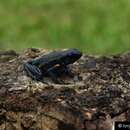tr
kırıntılardaki isimler


Ameerega ingeri, sometimes known as the Niceforo's poison frog, Brother Niceforo's poison frog,[1][3] or Inger's poison frog,[4] is a species of frog in the family Dendrobatidae. It is endemic to the Colombian Amazon.[1][3][5] It is known with certainty only from its type locality in the Caquetá Department.[1] Records from the Putumayo Department ascribed to this species likely refer to Ameerega bilinguis,[1] although other sources continue to include Putumayo in the range of Ameerega ingeri.[3][5]
The specific name ingeri honors Robert F. Inger, an American zoologist from the Field Museum of Natural History.[4] "Niceforo" in the common name refers to Brother Nicéforo María[4] who collected the type series.[2]
The type series consists of four specimens, the largest of which (the holotype) is at 27.5 mm (1.1 in) in snout–vent length. The body is elongate. The eyes are large and prominent. The tympanum is small but distinct. The fingers are long and they relatively small discs and slight lateral fringes; no webbing is present. The toes are long and have slight basal webbing. Skin is dorsally coarsely granular. dorsum in preserved specimens is slate black, but the top of head is little lighter and there are traces of a gray chevron mark in front of eyes. The venter is slate black, with slight indications of a coarse, light reticulation on belly.[2]
Ameerega ingeri occurs in tropical rainforest at 200 m (660 ft) above sea level,[1] or if more broadly defined, at 100–400 m (330–1,310 ft).[3][5] It is threatened by habitat loss—the area of the type locality is already deforested.[1]
Ameerega ingeri, sometimes known as the Niceforo's poison frog, Brother Niceforo's poison frog, or Inger's poison frog, is a species of frog in the family Dendrobatidae. It is endemic to the Colombian Amazon. It is known with certainty only from its type locality in the Caquetá Department. Records from the Putumayo Department ascribed to this species likely refer to Ameerega bilinguis, although other sources continue to include Putumayo in the range of Ameerega ingeri.
Ameerega ingeri[1][2][3] es una especie de anfibio anuro de la familia Dendrobatidae.
Esta especie es endémica de Colombia. Habita en los departamentos de Caquetá y Putumayo entre los 100 y 400 m de altitud en la vertiente oriental de la Cordillera Oriental.[4]
El holotipo mide 27,5 mm.
Esta especie lleva el nombre en honor a Robert Frederick Inger.
Ameerega ingeri es una especie de anfibio anuro de la familia Dendrobatidae.
Ameerega ingeri Ameerega generoko animalia da. Anfibioen barruko Dendrobatidae familian sailkatuta dago, Anura ordenan.
Ameerega ingeri Ameerega generoko animalia da. Anfibioen barruko Dendrobatidae familian sailkatuta dago, Anura ordenan.
Ameerega ingeri est une espèce d'amphibiens de la famille des Dendrobatidae[1].
Cette espèce est endémique de Colombie[1]. Elle se rencontre dans les départements de Caquetá et de Putumayo de 100 à 400 m d'altitude sur le versant Est de la cordillère Orientale.
Cette espèce est nommée en l'honneur de Robert Frederick Inger.
Ameerega ingeri est une espèce d'amphibiens de la famille des Dendrobatidae.
Epipedobates ingeri – gatunek płaza z rodziny drzewołazowatych.
Gatunek opisany został na podstawie pojedynczego osobnika złapanego w 1970[1].
Zdaniem Jungfera, Löttersa i Jörgensa (2000) gatunek ten powinien być przypisany rodzajowi Dendrobates[1].
Występuje tylko w jednym miejscu (jest to endemit): Asarrio, na rzece Pescado w nizinnej amazońskiej dżungli w kolumbijskim departamencie Caqueta. Prawdopodobnie posiada bardzo mały zasięg występowania, który obecnie został wylesiony dla hodowli bydła. Nie ma tam żadnych obszarów chronionych[1].
Bytuje na wysokości około 200 m n.p.m. Zamieszkuje nizinny las. Wiedzie w nim lądowy i dzienny tryb życia[1].
Samica składa jaja do ściółki. Samiec opiekuje się nimi aż do wyklucia się kijanek, po czym transportuje je do zbiornika wodnego tworzonego przez rośliny (epifity)[1].
Być może gatunek ten jest już wymarły. Od dawna[od kiedy?] bowiem nie natrafiono na żadnego osobnika, a jego środowisko naturalne zostało zniszczone[1].
Epipedobates ingeri – gatunek płaza z rodziny drzewołazowatych.
Ameerega ingeri là một loài ếch thuộc họ Dendrobatidae. Đây là loài đặc hữu của Colombia. Môi trường sống tự nhiên của chúng là rừng ẩm vùng đất thấp nhiệt đới hoặc cận nhiệt đới. Chúng hiện đang bị đe dọa vì mất môi trường sống.
Ameerega ingeri là một loài ếch thuộc họ Dendrobatidae. Đây là loài đặc hữu của Colombia. Môi trường sống tự nhiên của chúng là rừng ẩm vùng đất thấp nhiệt đới hoặc cận nhiệt đới. Chúng hiện đang bị đe dọa vì mất môi trường sống.